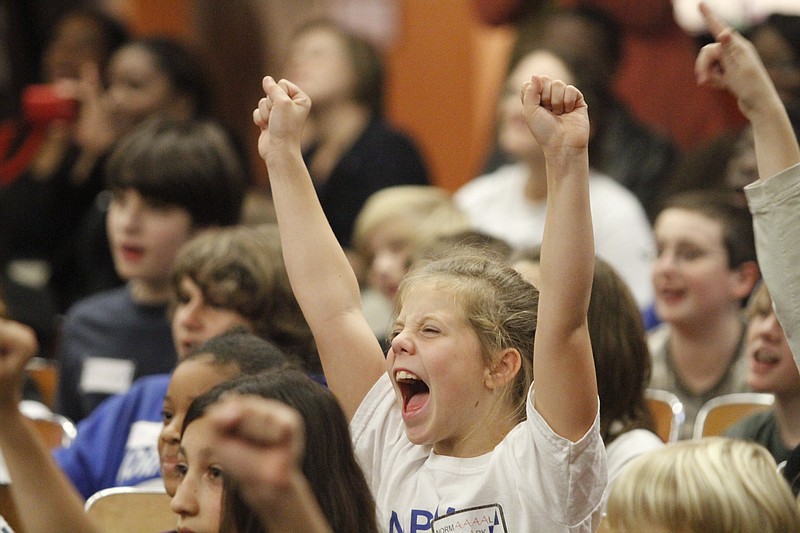Pardon us if we sound today like a broken record. But when a wheel is off-kilter, usually no one notices until it squeaks and grinds, squeaks and grinds, squeaks and grinds. Thus it is that every few weeks we squeak and grind about Hamilton County's public schools and county's dismal future because of those school failures.
Our squeak and grind is often not popular. Especially with community leaders.
Usually we talk only about 3rd-grade reading scores, but that doesn't seem to move people.
But two weeks ago we asked if, in school performance, the glass was half empty or half full because in July we saw that struggling youngsters haven't caught up -- or at least they didn't in two important subjects in 2022: Not quite 36% of Hamilton County students in grades three to 12 performed at or above grade-level expectations in English language arts and 44% were on grade level in social studies. What's more, we learned we are on par with the state's average -- even outperforming the state in some areas.
Then last week we challenged every elected city, county and state official in our county to expend as much energy fighting to find public money -- do whatever it takes -- for Hamilton County schools and students as we're set to do for our community's shiny new object, a $79.5 million stadium for the Chattanooga Lookouts.
That was really unpopular with our community leaders. Some even complained.
But let's be real.
On Sunday the Chattanooga Times Free Press laid out an exhaustive analysis of school scores. Far and away, the majority of educational assessments for Hamilton County students shows a lack of proficiency in one or more subjects. We're talking 63% of students -- nearly two thirds -- not making their grade level in all subjects.
Only 37% -- just over a third, not quite four in 10 -- had passing proficiency scores across all subjects.
We're told this passing proficiency score is more simply considered a success rate.
That 63% of tests that aren't showing success (yeah, we used to call that failure) is just an average.
The TFP's analysis found a whopping 45 of our 80 tested schools showed "success" at rates lower than the sad 37% low. Three schools tested as low as 5%. Only at 22 schools did more than 50% of students show proficiency in all of their subjects.
Yes, the COVID pandemic had an effect. It pulled the scores down for a couple of years, according to educators. Never mind that our children in Hamilton County and Tennessee were not away from school nearly as much as youngsters in others areas of the country. Those educators are happy to pat themselves on the back because this year's success rate has pulled up again to be almost the same as that of five years ago -- 37.5%
But there is one factor to consider when comparing our schools and scores to others across Tennessee -- a state that itself is not a stellar education performer.
The corollary is wealth and poverty. They aren't the be-all explanations. But they are big ones.
The state's highest performing county school district is Williamson where 70% of students had passing scores in all subjects. Rutherford scored 43%; Knox, 38%; Hamilton, 37%; Davidson, 23.4%, and Shelby, 18.1%.
These counties' poverty rates parallel those testing scores. Respectively, according to welfareinfo.org, those counties poverty rates are 4.6%, 11.8%, 15.8%, 14.5%, 16.9%, 20.8%.
Local community schools' testing scores follow the same pattern. Our top five schools are Nolan Elementary, Thrasher Elementary, Lookout Mountain Elementary, Hamilton County Collegiate High at Chattanooga State and the Chattanooga School for The Liberal Arts. Our struggling schools are Brainerd High School, Orchard Knob Middle School, Dalewood Middle School, Hardy Elementary and Chattanooga Charter School of Excellence Middle School.
Local school officials say they are trying to address the disparities between the wealthier and whiter schools and the more economically disadvantaged and minority schools.
"What you'll notice about these schools is that their demographic is mostly students who are historically underserved, said Hamilton County Schools Chief Strategy Officer Shannon Moody. "We recognize that low-achieving schools need time and extra resources to be able to help support our students."
Retired and much-respected Hamilton County educator Edna Varner, who now is senior adviser of Leading and Learning for the Public Education Foundation, says what we're doing -- while laudable -- isn't enough.
"We've got to do something different," Varner said. "We cannot do more of the same and do it harder and faster."
And it is not just about buying more study materials and Chromebooks.
"If kids are struggling because their families are constantly being evicted and they're moving from school to school, we can do something about that," she said. "If kids are being kept out of school, and when I was a principal I saw this, because parents couldn't afford day care, so they kept older children home, we can do something as a community about that."
The question, of course, is will we?
Varner correctly points out that there is no excuse for under-performing schools because we can see from those doing well that our school district already knows how to bring about success.
But clearly it takes a community.
And it takes a different set of priorities. It takes leadership in our community -- leadership that already has found a creative way to build a stadium. Now we all must work to find an equally creative way to build school success.
